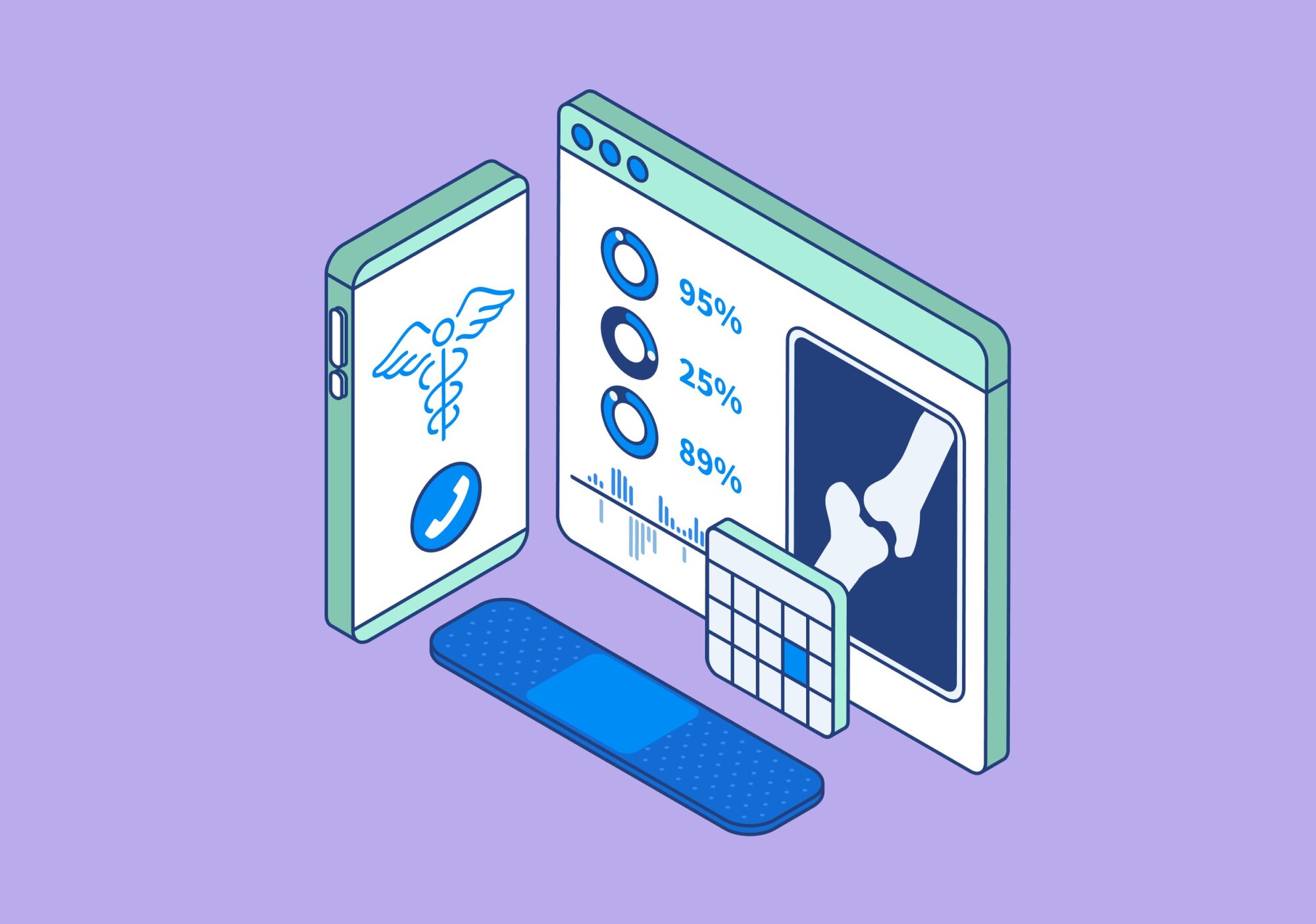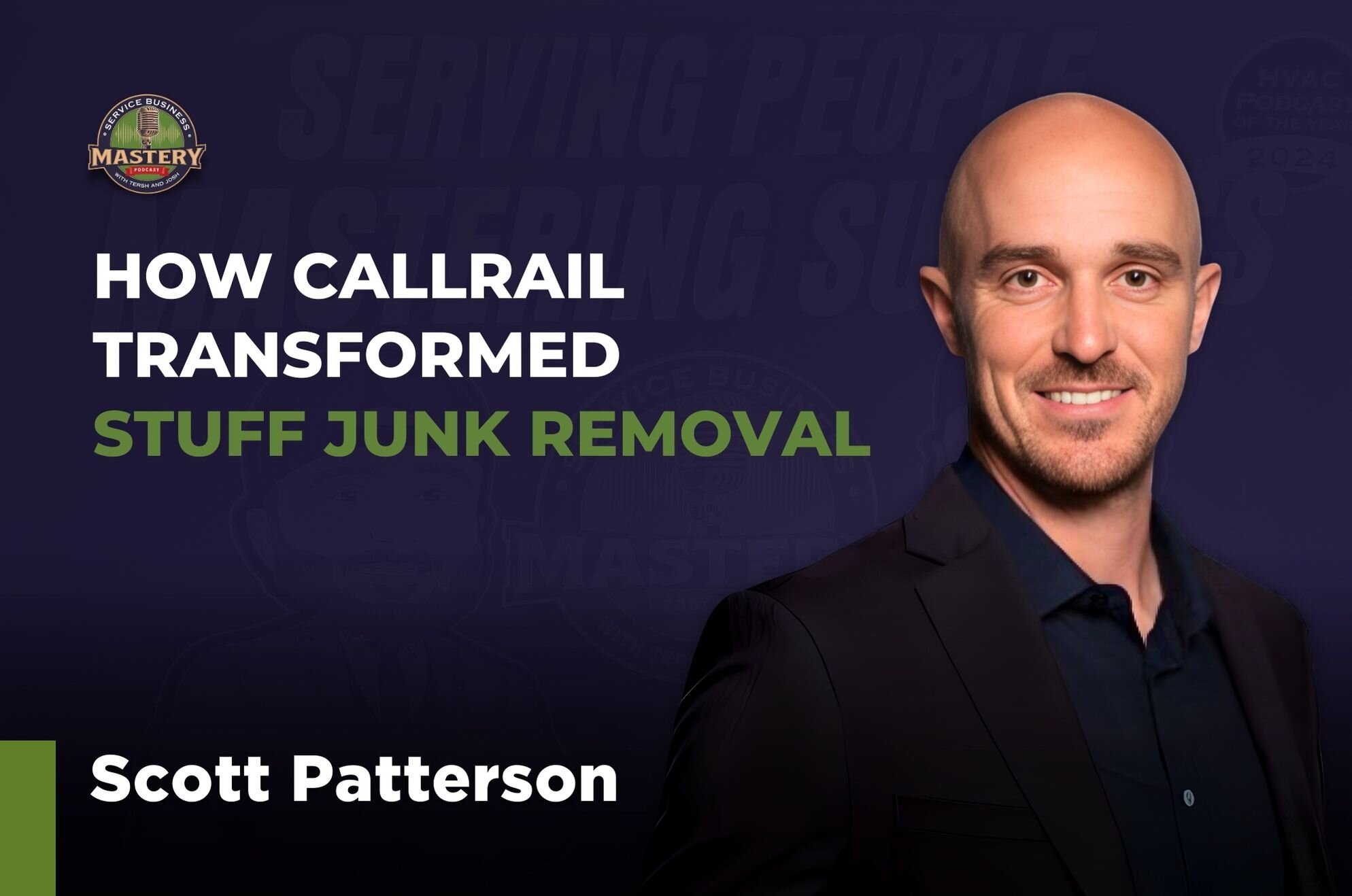Healthcare marketers have their work cut out for them this year as they confront key challenges like driving brand awareness, building patient trust, providing a positive patient experience, remaining HIPAA compliant, increasing labor and technology expenses, and the need to embrace generative AI.
These 23 healthcare marketing stats provide a glimpse into the trends that healthcare marketers should have top of mind this year so they can create and execute marketing strategies and tactics that keep healthcare consumer habits at the center – whether it is consumer sentiment around receiving healthcare services, how healthcare consumers conduct their research, or how they prefer to schedule appointments with their provider.
By leveraging these statistics to fuel your marketing campaigns, you’ll appeal to more of your ideal patients, enhance the patient experience, and ultimately generate more interest in your practice.
Healthcare providers are experiencing headwinds
1. 71% of healthcare providers say economic headwinds are the greatest challenge ahead. (Source: CallRail)
In a survey of healthcare providers, providers indicated that the economy would continue to have the biggest impact on business this year with 71% of the vote. Competition/crowded marketplace came in second with 50% of respondents indicating this will be a key challenge in the year ahead, and maintaining HIPAA compliance was the third biggest challenge for the new year with 27% of respondents weighing in.
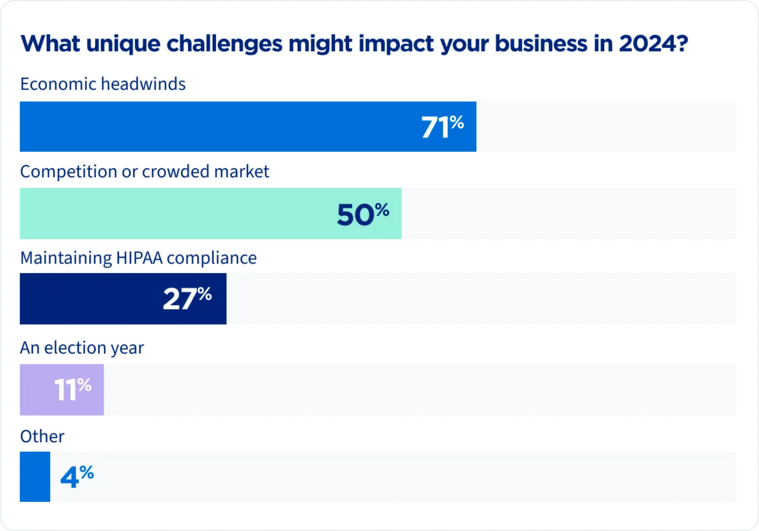
What this data means for healthcare marketers
Given the challenges healthcare practice owners, providers, and marketers face, it’s more important than ever to optimize marketing strategies and capitalize on every incoming lead. This information enables marketers to meet prospective patients where they’re at with compelling campaigns that speak to their individual needs, and by offering a positive and satisfying patient experience that drives loyalty.
Times are tough for American healthcare consumers
2. Nearly 40% of Americans skipped medical care in 2022 because of cost concerns. (Source: Gallup)
In 2022, 38% of Americans said they or a family member skipped or delayed medical care, amid the highest rate of inflation in more than 40 years, according to an annual healthcare poll. 27% of respondents said the treatments they skipped were for "very" or "somewhat" serious conditions or illnesses.
3. More than 1 in 4 adults delayed or did not get some form of health or dental care due to cost. (Source: KFF polling)
In 2022, more than 1 in 4 adults (28%) reported delaying or going without either medical care, prescription drugs, mental health care, or dental care due to cost. A smaller share of adults (15%) reported foregoing medical care, prescription drugs, or mental health care due to cost.
4. Half of working-age adults said it was difficult to afford their health care costs. (Source: The Commonwealth Fund)
Large shares of insured working-age adults surveyed said it was very or somewhat difficult to afford their health care: 43 percent of those with employer coverage, 57 percent with marketplace or individual-market plans, 45 percent with Medicaid, and 51 percent with Medicare.
5. Family healthcare premiums have increased 22% over the last 5 years. (Source: KFF)
This significant rise in healthcare costs mirrors the rate of inflation during the same five year period (21%), increasing the financial burden placed on families for healthcare expenses. When healthcare costs rise in line with inflation, it means families are allocating a larger portion of their income towards healthcare, potentially impacting their overall financial stability. This trend shows the importance of addressing healthcare affordability and accessibility to ensure that families can access necessary care without undue financial strain.
What these stats mean for healthcare marketers
These figures show that many people, even those with insurance coverage, are either delaying or forgoing medical care due to financial constraints. Healthcare marketers, therefore, may consider marketing campaigns that highlight proactive solutions to health conditions and alleviate concerns while emphasizing affordability, cost-effective solutions, and insurance coverage options while encouraging individuals to prioritize their health.
How healthcare marketers can use the patient health journey to their advantage
6. People come to Google with health-related questions hundreds of millions of times a day. (Source: Google Health)
People all over the world use the internet to search for medical information on Google – and in fact, 5% of all searches on Google are health-related. It won’t surprise many of today’s marketers in the medical industry that search engines are the number one place for people to find consumer health-related information.

7. People watched videos about health conditions 110 billion times globally. (Source: Google Health)
This statistic highlights the growing trend of people seeking health information and advice through visual content and a shift towards more accessible and engaging mediums for getting healthcare knowledge. Healthcare marketers should consider investing in video content to provide insight, build trust, and reach a broader audience in a format that resonates with today's consumers.
8. 84% of prospective patients use both online and offline sources to research healthcare providers (Source: Google)
Neglecting offline search methods would not be wise, as individuals gather information about healthcare practices from many different sources. It’s essential to consider offline strategies as well as online when promoting healthcare services. Think: word of mouth, incentivized referral programs, billboards, pamphlets, sponsorships, business cards, and community involvement.
9. 79% of surveyed healthcare providers are prioritizing website and SEO to reach new patients. (Source: CallRail)
When asked what tactics they planned to deploy to reach more new patients, website and SEO (79%), social media (64%), and email marketing (54%) were the top three marketing tactics chosen by providers. Non-digital tactics like events (43%) and print marketing (32%) ranked last.
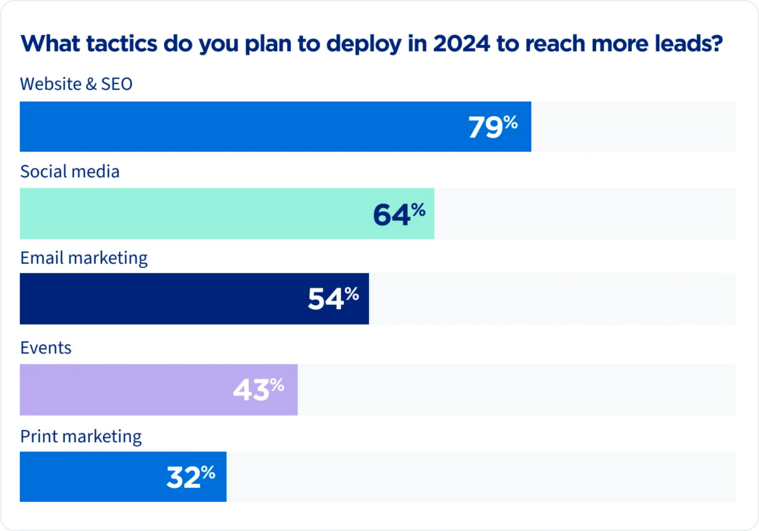
What this data means for healthcare marketers
These statistics emphasize the significance of online platforms, particularly Google, in healthcare information-seeking behavior and highlight the need for healthcare marketers to prioritize their online presence and SEO strategies to reach and engage with their target audience. After all, online is the best place to showcase why you, as a healthcare provider, deserve trust from the prospective patient.
The popularity of health-related videos shows the importance of visual content, encouraging marketers to invest in video (even minimally) for informative and engaging communication. Also, a multichannel approach is vital as patients rely on both online and offline sources for healthcare provider research, prompting marketers to consider offline tactics alongside digital strategies for an approach that covers the entire patient journey.
Patients look to online reviews as they evaluate potential healthcare providers
10. 96% of healthcare consumers said online reviews were an important part of the decision-making process when evaluating providers. (Source: BrightLocal)
Positive reviews serve as endorsements from previous patients, inspiring confidence in prospective patients regarding the quality of care and service they can expect. They also can improve the visibility of a healthcare provider in search engine results, making it more discoverable.
11. 94% of prospective patients said the reputation of a facility was the most important factor in selecting a healthcare practitioner. (Source: Google)
In a Google study, researchers found that respondents overwhelmingly rated reputation as a determining factor in selecting a provider. By fostering positive reviews and actively engaging with patients' feedback, medical practices can not only attract new patients but also establish a lasting and positive online presence that drives growth.
12. 66% of healthcare consumers said Google is the most used and trusted platform for reviews. (Source: BrightLocal)
Since prospective patients overwhelmingly seek provider reputation information from Google Business Profile, it’s important to claim your profile and keep it updated so satisfied patients can identify your practice and leave positive feedback after their visit.
13. 81% of healthcare consumers are ‘likely’ or ‘highly likely’ to write a positive review. (Source: BrightLocal)
When patients are satisfied with their experience, they're willing to vouch for their healthcare providers with a positive endorsement online. Physician review sites like Vitals and HealthGrades also drive new appointments so marketers should ensure they have a system for encouraging positive reviews and mitigating negative ones.
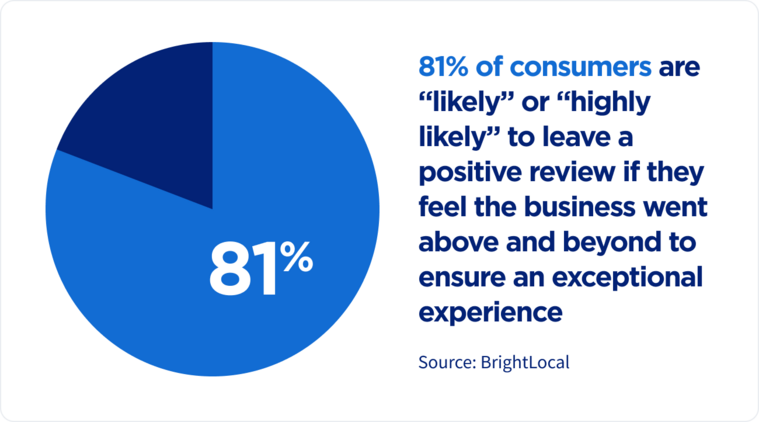
Why these stats matter for healthcare marketers
These statistics show the importance of online reputation management for healthcare marketers, as positive reviews significantly influence patients’ decisions. With the majority of prospective patients relying on Google as the most trusted platform for reviews, it's essential for healthcare practices to actively engage with patient feedback and maintain a positive online presence to attract and retain patients. Taking advantage of this fact can drive new appointments and enhance the overall reputation of the practice as healthcare consumers increasingly turn to digital channels to manage their healthcare needs.
Healthcare marketers are using digital marketing tactics to reach new patients
14. U.S. healthcare advertising spend will increase at a growth rate of 4.6% through 2028. (Source: The IMARC Group)
According to forecasts, healthcare ad spend in the US will increase from $22.4 billion in 2022 to $29.2 billion in 2028. That increase in spending shows healthcare organizations are intensifying their marketing efforts to capture market share, making it essential for marketers to stay competitive and adapt to changing consumer expectations.
15. Forecasts predict increased digital ad spending from $15.84 billion to nearly $20 billion. (Source: Insider Intelligence eMarketer)
With more budget allocated to digital advertising, healthcare marketers need to adapt their strategies to effectively leverage online channels, optimize their digital presence, and engage with their target audience where they are increasingly active.
16. The average cost for an organic healthcare lead is $320, and a paid digital campaign lead is $400. (Source: FirstPageSage)
Understanding this cost allows healthcare marketers to evaluate the efficiency of their lead generation strategies, ensuring that their marketing efforts are cost-effective and yield valuable leads. It also helps them make informed decisions on resource allocation, channel selection, and campaign optimization to maximize ROI.
17. 68% of surveyed providers plan to use AI to solve lead generation and qualification challenges. (Source: CallRail)
In one survey, a majority of respondents (68%) in the healthcare industry acknowledged the potential of AI to assist with lead generation and qualification, while 36% said they’ll use AI to generate copy for marketing tasks. The respondents noted that healthcare practices and those who work in the industry need to take extra caution with AI.
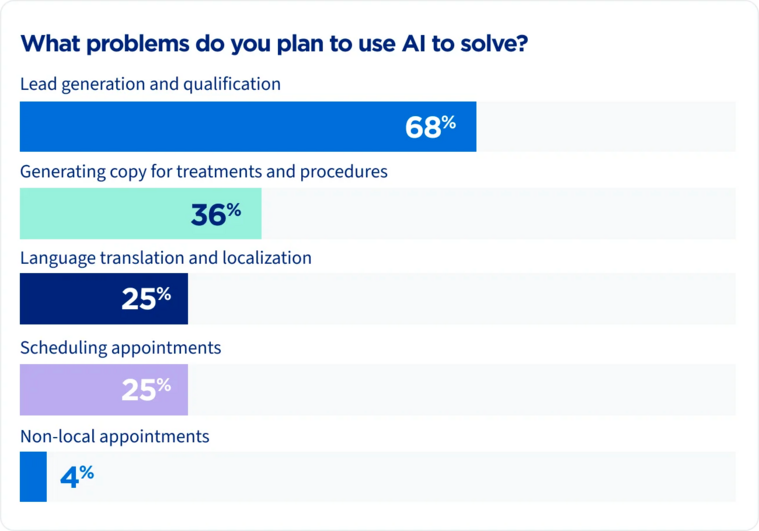
Why this data matters to healthcare marketers
These statistics highlight the significant shifts in advertising trends and lead generation strategies in the medical industry. With a substantial increase in advertising spend, especially in digital channels, marketers must refine their ability to track spend and report on channel performance, convert as many leads as possible, and efficiently reallocate funds from underperforming channels.
The growing adoption of AI for lead gen shows how important it is for marketers to stay current with emerging technologies and tactics and incorporate both into their workflow while remaining aware of ethical and compliance implications.
Healthcare marketers must be prepared to convert prospective patients by phone or online
18. 85% of healthcare consumers still prefer to schedule appointments by phone. (Source: Health Leaders Media)
Despite research that shows online appointment scheduling is on the rise, a large number of prospective patients still want to call the office for an appointment – and healthcare marketers need to streamline the caller experience to satisfy prospective patients.
19. 47% of consumers prefer phone calls when interacting with healthcare providers. (Source: HIYA).
Downplaying phone calls would be a mistake for healthcare marketers given nearly half of consumers prefer the phone for general communications with their healthcare providers. Today many people assume that digital channels are key and people don’t want to use the phone at all – but that’s just not accurate. Phone calls are not dead and medical consumers still appreciate the privacy and security they provide when sharing sensitive and personal information.
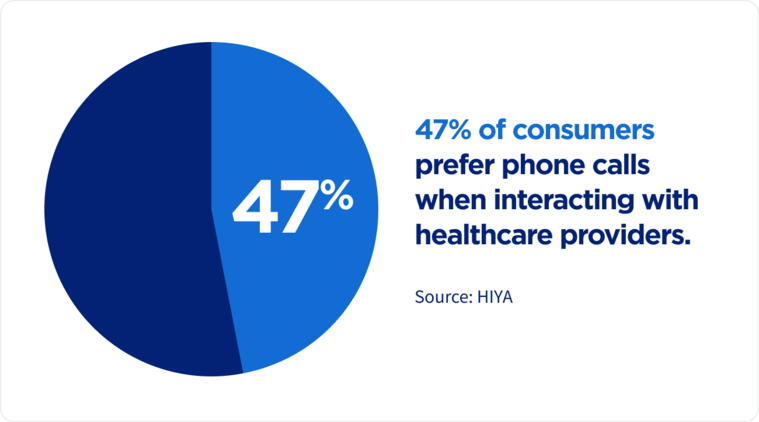
20. 39% of Gen Z people prefer to get customer care over the phone. (Source: Finances Online)
This is significant as it challenges the assumption that younger consumers exclusively favor digital channels. Healthcare providers and marketers should consider preference when developing patient engagement strategies, ensuring they offer comprehensive and adaptable patient service that caters to various preferences.
21. Patients prefer to make appointments online 43% of the time. (Source: Finances Online)
Healthcare providers and marketers should consider online appointment scheduling systems to meet demand. Failing to adapt to this trend could result in missed opportunities to attract and retain patients who prefer the convenience of online appointment booking.
What these statistics mean for healthcare marketers
These statistics reveal the varied communication preferences among healthcare consumers and the channels they use. The preference for phone calls cannot be ignored as a substantial portion of consumers still use the phone for scheduling appointments and general communications.
Since many Gen Z individuals prefer phone-based customer care, this challenges assumptions about digital-first preferences among younger demographics. Although many consumers enjoy the ability to schedule appointments over the phone and call their providers to discuss sensitive issues, they also enjoy the option to schedule online. Today’s marketers need to plan for every scenario as they develop their strategies.
Drive more revenue for your practice by optimizing your marketing
22. Healthcare practices can reduce marketing costs by greater than 20% by using call tracking and AI. (Source: CallRail)
Call Tracking provides healthcare marketers with real-time information on advertising, marketing, and email campaigns — both online and offline — by allowing them to track the source and previous activity of every visitor to reduce customer acquisition cost (CAC). Call attribution connects incoming calls to marketing and promotional efforts as well as visitor tracking, reducing excess spend on underperforming channels and campaigns.
When paired with Call Tracking, an AI solution like CallRail Conversation Intelligence™ provides automatic lead qualification, tagging, scoring, and keyword spotting to help healthcare marketers improve their ad copy and bidding strategy based on real call data and insights from Google Ads.
23. Healthcare practices may be able to increase ROI up to 400% in one year by implementing CallRail Call Tracking. (Source: CallRail)
Companies like healthcare organizations that rely on inbound phone calls to generate leads, set appointments, and grow their practice often have little visibility into which of their marketing campaigns are the most effective. Marketing dollars are spent on multiple channels, and without a solution to track, monitor, and analyze the inbound calls, it is virtually impossible to know which messaging channel generated a call.
Read the full study to learn how companies use CallRail to solve these challenges.
So how can healthcare marketers use data to beat their competition this year?
Healthcare marketers face various challenges and opportunities that can be addressed with the following actions:
-
Optimize Marketing Strategies: Given the economic headwinds
as the top challenge for healthcare providers, marketers should focus on
optimizing marketing strategies to capture leads efficiently and maximize
ROI.
CallRail
helps marketers track where their best leads are coming from so you can
spend smarter on everything from paid search to print ads.
-
Emphasize Affordability: Recognizing that many patients
delay or skip care due to cost concerns, marketers should develop campaigns
that emphasize affordability, cost-effective solutions, and insurance
coverage options.
Call Tracking
provides marketers with insights into what challenges prospective patients
are calling about as well as what content drove them to pick up the phone
and call.
-
Leverage Online Presence: As people turn to Google and
online videos for health-related information, healthcare marketers must
prioritize their online presence, SEO, and video content to engage with
their audience effectively.
- Take a multichannel Approach: Healthcare marketers should adopt a multichannel approach, recognizing that patients use both online and offline sources to research providers, requiring a mix of digital and traditional marketing tactics. Marketers use CallRail to easily track all their online and offline leads – so it’s never a mystery where your best leads came from, which channels are draining money, and where to reinvest or reallocate ad spend.
-
Harness the Power of Reviews: Since online reviews play a
crucial role in patient decision-making, marketers should actively encourage
positive reviews, manage negative feedback, and ensure a strong online
reputation.
-
Stay Competitive Digitally: With rising healthcare
advertising spend and increased digital ad spending, marketers need to adapt
their strategies to leverage online channels effectively and engage with
their active audience.
-
Evaluate Lead Generation Costs: Healthcare marketers should
analyze the cost of leads generated organically and through paid campaigns
to ensure cost-effectiveness and informed resource allocation. Tools like
Form Tracking
help marketers get a complete picture of their leads’ journeys – including
each piece of content they viewed on their path to reach out to your
practice – providing insight about the challenges they are looking to your
practice to solve that you can use to tweak your messaging and convert at a
higher rate.
-
Accommodate Patient Preferences: Recognizing that patients
still prefer phone calls and online appointment scheduling, marketers should
provide user-friendly online scheduling options and work to streamline the
caller experience. Marketers use
Conversation Intelligence
to analyze all their calls, all the time with AI – turning conversations
into actionable insights that help convert more leads, boost frontline team
performance, and drive revenue growth.
-
Consider Diverse Demographics: Acknowledging that Gen Z
prefers virtual care and online appointment scheduling is on the rise,
marketers should cater to diverse demographic preferences. Premium
Conversation Intelligence® helps healthcare marketers anticipate patient
preferences with
call summaries
and
call sentiments
which sum up conversations in a few sentences and tell you whether calls
were negative or positive so you have accessible call data to support
strategic decisions.
- Explore AI Opportunities: The potential of AI in healthcare marketing should be explored cautiously, with healthcare practices considering the benefits and challenges associated with AI adoption. Marketers should ensure that any AI tools they employ in their strategies support HIPAA compliance.
By incorporating these actions into their marketing strategies, healthcare marketers can move with confidence, meet patient needs effectively, and drive growth for their practices.



